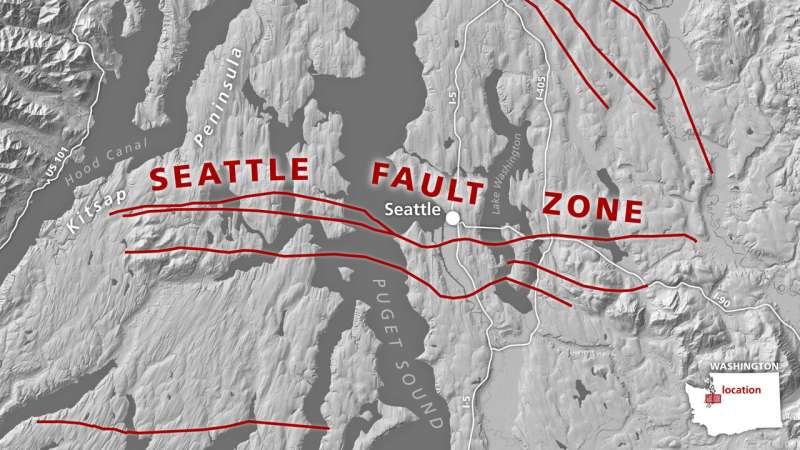Seattle Fault's Deadly Origin Story Unveiled

February 6, 2024
This article has been subjected to Science X's rigorous editorial procedures and standards. To ensure its credibility, editors have undertaken the subsequent measures:
- Fact-checked
- Trusted source
- Proofread
It was overseen by Rebecca Dzombak from the American Geophysical Union.
The Seattle Fault Zone, a group of shallow faults threatening over four million residents with potential earthquakes, cuts across the Puget Sound lowlands.
A fresh study offers a new perspective on the origin of the fault system, which could aid scientists to refine hazard modeling for the high-density region. This study is published in the Tectonics journal.
According to the study, the Seattle fault is today's active due to the strain from ongoing tectonic deformation from the west and south. However, this wasn't always the case. Vintage Washington in the Eocene era looked different with its coastline significantly east of contemporary Seattle and dotted with volcanic islands.
The study proposes that the aforementioned island chain approached the continent around 55 million years ago. This movement resulted in portions of it moving over the crust as the remaining parts went underneath. The crust would have sustained enormous strain, and a tear created two parts. This ancient tear set the geological foundation for today's Seattle fault, argue the study authors.
Commenting on the study, Megan Anderson, a geophysicist with the Washington Geological Survey and the lead author, stated that the results were unexpected. They predicted a significant ancient fault which coincides with the location of the current Seattle fault.
The Cascadia subduction zone lies close to the Pacific Northwest; it is where the dense oceanic crust is pulled beneath the continent. In 1700, a large-scale rupture of the subduction zone led to a massive quake. The most recent quake was the 2001 Nisqually earthquake.
Based on indigenous oral histories and geologic evidence along the Puget Sound shoreline, the Seattle fault had a notable rupture in 923-924 AD.
Despite the seismic activity, the Seattle Fault Zone didn't undergo comprehensive study until the 1990s.
Anderson observes more uncertainty around the Seattle fault compared to the San Andreas fault. The risk of a magnitude 7.2 earthquake from the Seattle fault necessitates preparation. She adds there is much left to learn to support engineering geologists in conducting effective earthquake simulations and assessing potential community risks.
Anderson and her colleagues attempted to test present assumptions on the fault zone's geometry through mapping kilometers-deep bedrock across Western Washington to develop a comprehensive picture of the region's geological structure.
The team used computer models to verify if any of the existing hypotheses corresponded with the seismic, gravity, and magnetic data collected. The magnetic data indicated alternating magnetic influences in the bedrock, suggesting layers of rock with varying type.
Features flanking the Seattle fault zone angle away from each other north of the zone, the structures angle north-northwest, while in the south, they're oriented north-northeast.
Anomalies in these orientations pointed to an ancient mountain range which provided Anderson the lead to verify the theoretical view using deeper rocks. To align this theoretical view with known, deeper bedrock geology, Anderson modelled a vertical cross-section of underground rocks and discovered structures dipping at differing orientations underground as well.
'These are all very different orientations,' Anderson said. 'It's very hard to do that unless there's a place where the structures get disconnected from each other and then restart.'
Anderson had stumbled upon a new possible explanation for the Seattle fault zone's early history and why it's reactivated today.
The data suggested that about 55 million years ago, as the subduction zone pulled in a string of oceanic islands, the northern half of the island chain was subducted, but the southern half was added to the top of the crust, or obducted. Over a couple million years, as the islands were obducted, they crumpled into a fold-and-thrust mountain belt with topography similar to the Blue Ridge Mountains of Appalachia today.
The zone where the islands switched from being subducted to being accreted would have been under incredible strain and been ripped apart.
'It would have been this slow, ongoing tear, almost like the crust unzipping itself,' Anderson said. 'As this progressed, the tear fault got longer and longer.'
And that 'torn' region overlaps perfectly with the modern Seattle fault zone.
The intense tearing would have stopped after the islands were crunched into the continent, but the damage was done. The zone of intense tearing created a fragmented, weakened crust, setting the geologic stage for the modern Seattle fault zone.
Beyond explaining why the fault zone exists, the study's results about the geometry of Washington's more ancient faults and geologic structures provide valuable details about the bedrock under and within the Seattle basin. This basin is filled with kilometers of looser sedimentary rock, which makes seismic ground shaking stronger, and the new data can help scientists make more accurate models of future ground shaking in the area.
Anderson is excited to use her findings to study western Washington's active faults next.
'This buried tectonic story was so much fun to discover, and now it will provide a great basis for getting back to answering our original questions about active fault geometry for the Seattle fault and other faults in western Washington,' Anderson said.
Provided by American Geophysical Union




